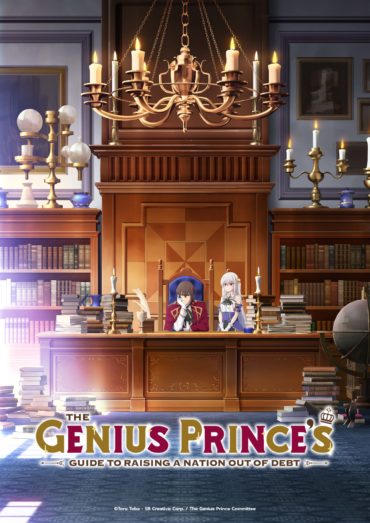Winter 2022 Preview: What We’re Watching …
Is it quality rather than quantity that counts with the new series being streamed for the new year? Certainly, there seem to be even more isekai than ever if that were possible (but perhaps that’s just the slightly jaundiced view of this editor) and the perennial question is: are any of them worth watching? However, not quite so many titles overall as in the Autumn ’21 Season but with Attack on Titan returning for its final titanic climax and apotheosis, every other new show has a great deal to live up to. Undaunted, the writers at Anime UK News are here to share their first impressions – and to choose a few early favourites. Whether they’re still our favourites by the end of the season remains to be seen…
Ian Wolf
Sundays are currently very busy days for a lot of anime fans, as they try to watch the latest episodes of Attack on Titan and Demon Slayer while hoping their streaming services don’t crash. However, there are other anime going out on the same day which deserve our attention.
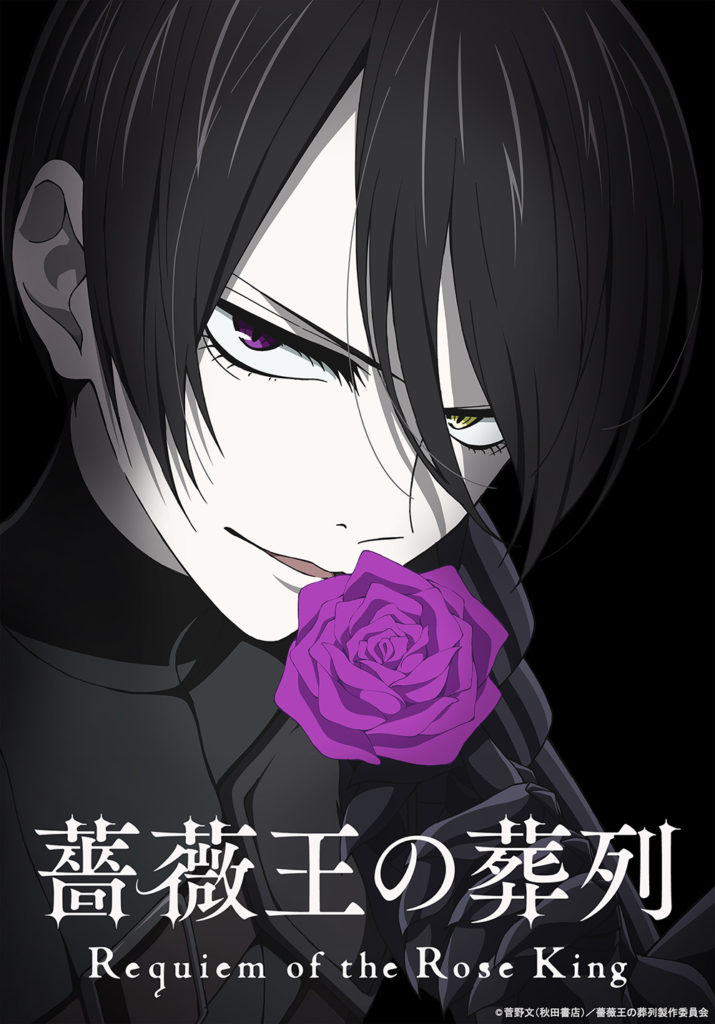
From a British perspective, Requiem of the Rose King (Funimation) should be one to interest viewers, given that this series is about one of our most famous monarchs, loosely based on the works of our most famous writer.
Aya Kanno’s original manga (released in English by VIZ Media) is based on William Shakespeare’s Wars of the Roses plays and follows the life of Richard III, or rather the boy who becomes Richard III. Even then, “boy” is not strictly accurate as this version of the future monarch is intersex rather than hunchbacked. Along with different-coloured eyes and his slick black hair, it would seem the Japanese are under the impression that one of most famous kings was a goth. The series already has its fans, with no less than the great Moto Hagio describing the series as being more interesting than Shakespeare’s original plays.
The story follows not only Richard’s struggles with his own body, but with his family and with the kingdom as a whole as the Wars of the Roses rage. While out in the wood, the young Richard encounters a man we learn to be the devout Henry VI, a man who would rather be a Christ-like shepherd than a king. In the first two episodes Richard is kidnapped and escapes the clutches of the Lancastrians. It not just enemy soldiers who despise Richard; due to his body his own mother, Cecily Neville, utterly hates the “demon child” she spawned. Meanwhile, Henry VI’s queen, Margaret of Anjou, is only interested in power, regardless of her husband’s happiness. It has to be said that so far none of the women in Requiem of the Rose King come across positively.
One of the best things about the anime adaptation so far has been the use of colour. The animators really catch the grey misery of medieval England – a sentence which also works perfectly well if you remove the word “medieval”. It perfectly fits the mood of the show, combining with the wartime setting and Richard’s gothic vibe. Then there are times when really bright colours also appear, haunting Richard’s dreams as he is disturbed by visions of Joan of Arc.
Perhaps the most interesting aspect of Requiem of the Rose King however is this: if there were another anime on right now about another non-Japanese historical figure, the press in the respective country of said figure would be writing articles about it. If there was an anime about an intersex Abraham Lincoln for example, there would be plenty of pieces written about it, not just in the usual anime-themed places, but undoubtedly the mainstream US national press too. It speaks volumes about anime’s reputation in the UK that an anime about one of Britain’s most famous rulers is currently generating zero interest in our mainstream media.

Airing on Monday afternoons, new shonen series Sabikui Bisco (Rust-Eater Bisco, Crunchyroll and Funimation) is an adaptation of a light novel by Shinji Cobkubo (released by Yen Press), and is at least partly interesting in being a light novel adaptation that isn’t an isekai.
This post-apocalyptic story takes place in a Japan that has been turned into a desert by a disaster called the “Rusty Wind”, with people often becoming inflicted by deadly rust-related illnesses. The central protagonist, Bisco Akaboshi, is labelled the “mushroom terrorist”, as he is able to sprout gigantic mushroom plants by shooting arrows from his bow, causing untold chaos. His teacher, Jabi, is falling ill to the rust, so Bisco is trying to find the “Rust Eater” mushroom to cure him, while all those around him are trying to arrest him for the damage he has caused thanks to his shrooms.
In his travels to one city (riding on the back of a gigantic crab), Bisco encounters the medic Milo Nekoyanagi, nicknamed Dr. Panda due to his permanent black eye. As Bisco’s a wanted man, he brings danger to Milo simply by meeting him. Milo finds himself agreeing to help heal Jabi, while Bisco ends up fighting both the private armies of the city’s governor, and the city’s police or “Watch” led by Milo’s rust-infected sister Pawoo.
So far in the opening two episodes, there have been plenty of action and battles already. Bisco’s powers are particularly interesting, combining a rather old-fashioned weapon with this supernatural aspect of growing gigantic mushrooms once the arrow hits its target. As highlighted earlier with the giant crab that Bisco rides on, there is an interesting use of animals too. We see Bisco attacked by hippos with cannons on them, leading to a fight scene in which we learn Bisco has superhuman strength, in that he is capable of lifting up such a large creature and throw it. In another scene, Bisco is in a battle with an “escargot fighter”, a combination of slug and warplane.
In these opening episodes the storytelling has taken a non-linear format, cutting back-and-forth between the fighting in the city, the telling of Bisco’s relationship to Jabi, and the telling of Milo’s medical background, which later culminates with his encounter with Bisco in the opening episode. Because of all the action, the telling of the actual plot has been rather slow thus far, so you might be able to catch up quickly by reading the original novel.
Overall, an OK start, but the plot does need to build up more in order to sustain my interest.
Requiem of the Rose King is streaming on Funimation and Sabikui Bisco (Rust-Eater Bisco) is on Crunchyroll and Funimation.
Demelza

I confess I finished the Autumn anime season with a heavy feeling of fatigue. So many shows started well only to slip up down the road or were adaptations of things I enjoy but handled poorly. Nevertheless, I march onward, ready and hoping to find better adaptations of the manga and light novels I’ve become fond of. That said, this season has seen the return of How a Realist Hero Rebuilt the Kingdom, The Case Study of Vanitas and Princess Connect so if all else fails I have some promising sequels to fall back on! But when it comes to new shows, I’ve been looking forward to The Strongest Sage with the Weakest Crest and The Genius Prince’s Guide to Raising a Nation Out of Debt.
Strongest Sage is being adapted by J.C Staff (always a good sign!) and so far so good in terms of it being a solid adaptation of the source material. The story follows Mathias, the world’s most powerful sage, who decides to reincarnate himself into the future in order to obtain even more power. Once reborn, he sets off to attend the nearby magic academy and train himself to once more become the most powerful person in the world.
If you’re familiar with the manga (released in the West by Square Enix), then you’ll immediately notice the character designs are slightly different to what we’re used to since they’re based on the light novel illustrations, but thankfully this only took an episode to get used to and now I’ve grown quite attached to them. Since Mathias is a battle junkie who dreams of nothing but facing off against powerful enemies, it’s crucial that the fight scenes are well animated and I’m happy to say the anime has delivered in that department so far! The show is certainly nothing new in terms of its premise, but if you’re an existing fan of the series or simply looking for a fun battle series then this is worth checking out.
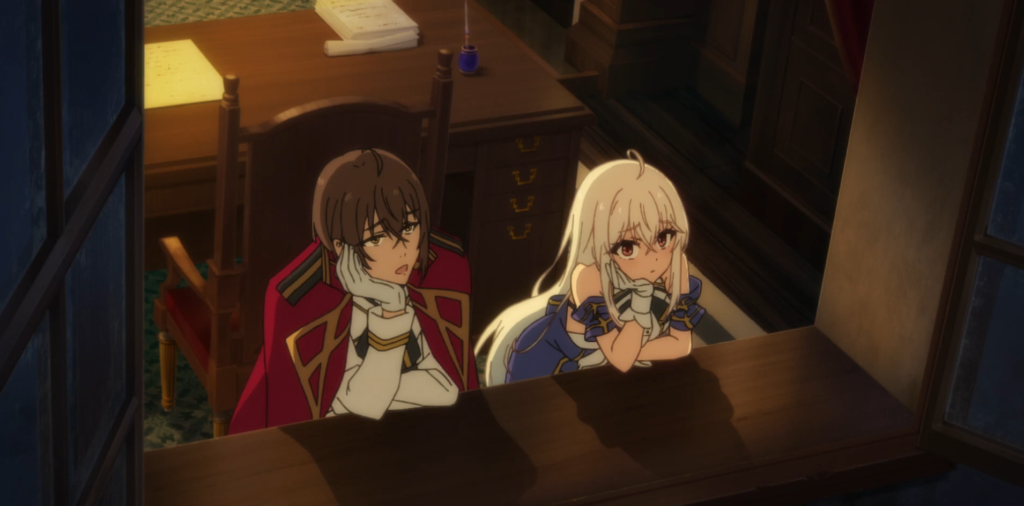
My second pick The Genius Prince’s Guide to Raising a Nation Out of Debt is perhaps easily mixed up with How a Realist Hero Rebuilt the Kingdom given they’re both based on light novels and both ‘kingdom builders’, in actuality, the two are quite different – for one Genius Prince is not an isekai! Our story follows Prince Wein, whose kingdom is flat broke, and who dreams of nothing but selling off the country and escaping to live a comfortable life somewhere else. Unfortunately for our protagonist, everything he does to try and get rid of the kingdom only ends up accidentally winning important battles and gaining the favour of his people.
Unlike Realist Hero was puts a focus on shaping policies and the intricacies of politics, Genius Prince is a comedy first and foremost. The anime adaptation (handled by Yokohama Animation Lab) leaves a lot to be desired in terms of appearance and its tendency to rely on CGi, but the one thing I will say is that they have nailed Wein’s character. Wein is voiced by Soma Saito (Hermes in DanMachi), who delivers an excellent performance that captures the prince’s tendency to be eccentric and wail about his situation and the animation has captured Wein’s inner monologues by showing a chibi version of him during key moments. I’m glad they worked out how to keep these sections since they are a big part of why the comedy works so well in the light novels. This might not be the anime I dreamed of for Genius Prince, but it’s certainly proving better than I anticipated and some of the light novel to anime projects we saw in 2021.
Like Strongest Sage, this isn’t the most unique premise out there but it is a lot of fun if you’re looking for a solid comedy. Fans of Realist Hero would also appreciate it, given it’s different enough in its set-up and direction not to overlap heavily beyond the fact the protagonist are both in positions of power over their countries.
The Strongest Sage with the Weakest Crest is streaming on Crunchyroll and The Genius Prince’s Guide to Raising a Nation Out of Debt is on Funimation.
Sarah

When I first began to review the much-anticipated BL manga of Sasaki and Miyano, I wondered what all the fuss was about. Some people insisted loudly and angrily that it was Boys’ Life not Boys’ Love! Really? (Compare and contrast with The Daily Lives of High School Boys.) The first chapters were gently amusing, occasionally touching yet often restricted to capturing a single interaction by the frequent use of 4-koma. But the manga and the anime series are so much more than a collection of 4-koma snapshots.
Sasaki and Miyano are senpai and kouhai at an all-boys high school. Sasaki stands out because he is tall, defiantly dyes his hair red (well, auburn) and has piercings in his ears. Miyano has ‘girly features’ which he hates and is serving on the school disciplinary committee. He is also, unusually, a fudanshi – although he insists that his obsessive fascination with BL is not because he’s gay, oh no, not him, he just enjoys the stories. The two first meet when Miyano’s friend is being beaten up by some other boys and Sasaki steps in to save him. After that, a friendship begins to develop between them. Miyano enthuses – in spite of himself – about BL and Sasaki, in a friendly way, asks if he can borrow a manga. Then another. And another – always passed across by Miyano in a plain bag, hissing to Sasaki not to open the bag in public but only to read it in his own room at home. Because BL! (A BL fanboy lives in the shadows…) 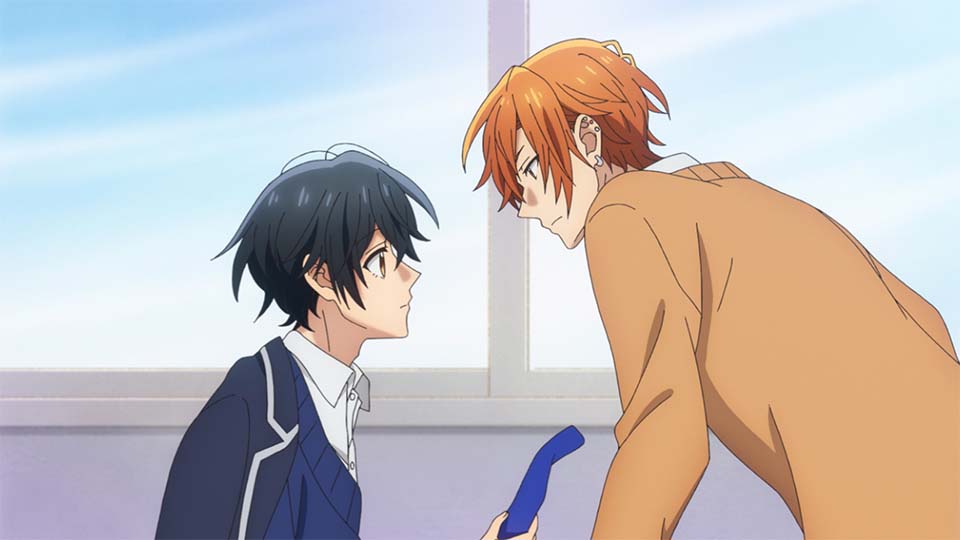
The anime TV series from Studio DEEN (currently on Funimation – yet another Sunday release) has captured all that makes this series work so well as a manga (the voice actors have already been playing their roles on the drama CDs, which helps). The character designs are instantly recognizable from mangaka Shou Harusono’s attractive originals and are well animated for what is essentially a slice-of-life tale about growing up and the pains and perils of first crushes/loves, enlivened with little touches of affectionate humour. The schtick of the story is that Miyano is in constant denial about his own feelings. Of course he’s not gay! He won’t always have these girlish features, he’s sure that he’ll grow out of them and grow taller too. (And he had a girlfriend in middle school.) In the meantime, Sasaki keeps dropping round to his classroom which annoys him – and yet he also really enjoys hanging out with his senpai.
The anime uses little clouds of confetti-like flowers and pastel-coloured shapes to drift across the scene whenever feelings are involved – and because these are well animated (sometimes they burst and disintegrate in a little puff of fine dust when feelings are frustrated or disappointed) they add to the emotional visual language of the story-telling in true shojo style. There’s also an adorable school cat who occasionally trots in and out of the frame, washes itself, dozes, and tries to catch dragonflies. The music, by Kana Shibue (Descending Stories: Showa Genroku Rakugo Shinju) has been understated (in a good way) and in Episode 2 creates a genuinely magical moment out of an everyday scene, conveying Sasaki’s conflicted feelings.
This is the first BL anime TV series set in a high school since the excellent Hitorijime, My Hero and Given and it’s another example of the greater breadth of character-based slice-of-life BL that’s flourished in the last few years. This entertaining look at a friendship that is becoming something deeper is the epitome of the slow burn and none the worse for it. A series for anyone who likes character-driven slice-of-life anime.
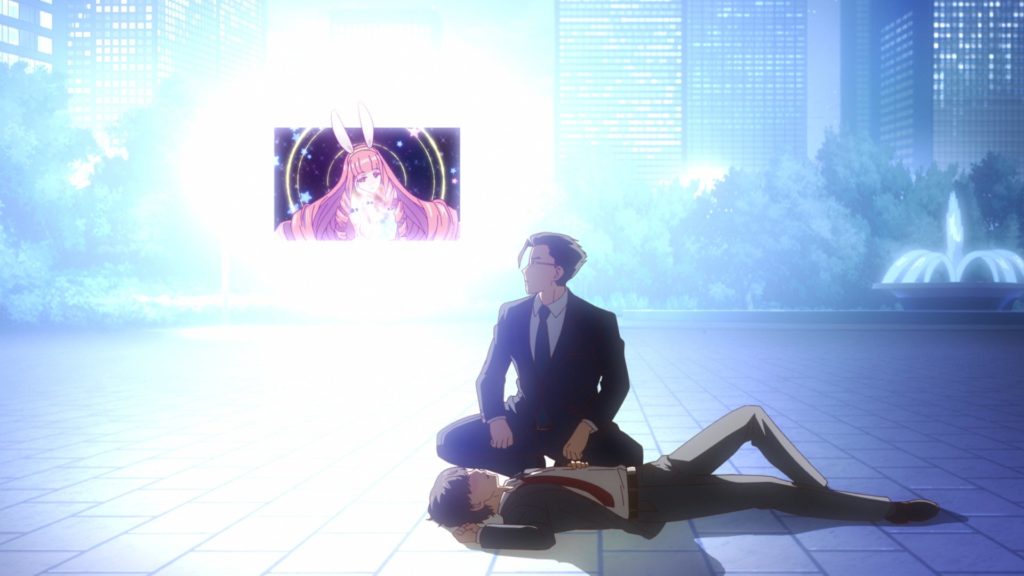
I can’t resist anime that play up the baka angle of an isekai premise (it all dates back to Kyo Kara Maoh which managed to balance some serious fantasy elements while indulging in some deeply stupid and loveable comedy). So I have hopes for Life with an Ordinary Guy Who Reincarnated into a Total Fantasy Knockout (Crunchyroll) based on a 2019 manga by Shin Ikezawa and Yuu Tsurusaki.
Tsukasa Jinguuji and Hinata Tachibana are 32-year-old salarymen who have known each other since childhood. On the way home after a heavy drinking session, Tachibana falls over and, as he’s lying on the pavement, complains, “If I’m always going to feel this small and miserable, I’d rather just become a woman. I want to be a girl so beautiful that I couldn’t possibly exist in this world.” Cue the unexpected appearance of a goddess who not only grants his wish but whisks him and Jinguuji off to a fantasy world where they must defeat the demon lord in order to return to how they were before. Tachibana is now a slender, blonde young woman – and the stoical Jinguuji has to face the fact that his childhood friend has suddenly become a very attractive member of the opposite sex.
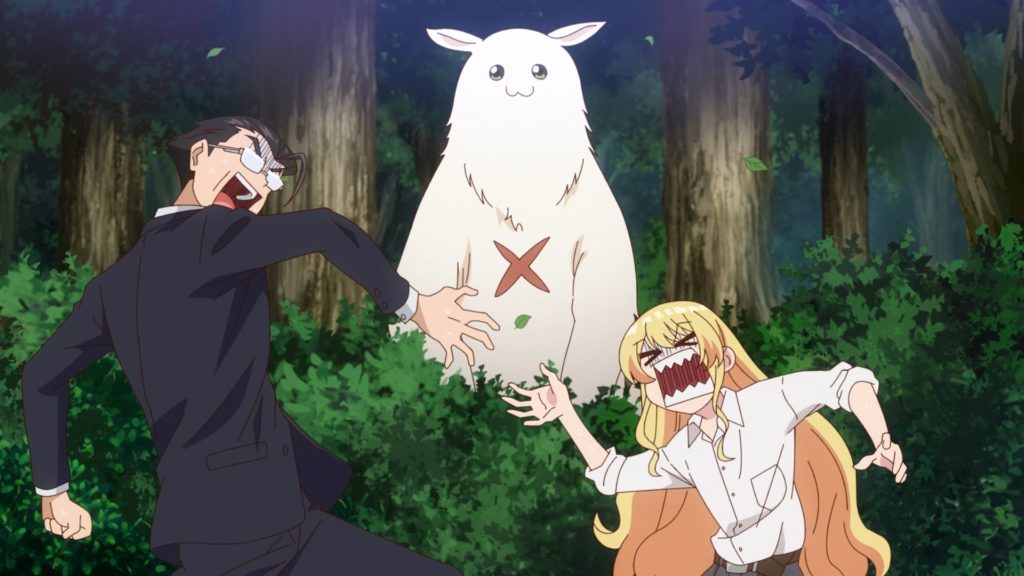
And so the two childhood friends set off on their journey through a stereotypical online fantasy game world with the inevitable scores and ratings appearing ‘on-screen’ as they try to get their bearings: scenic ‘non-Japanese’ villages; bandits; bizarre creatures/monsters; elvenfolk… (and that’s only up to Episode 2!)
If Miyano’s schtick is that he’s in complete denial about his own sexuality while devouring anything to do with BL, the schtick here is that Jinguuji has been perfectly happy to stay ‘friends’ with Tachibana to the extent that he’s never married or found a girlfriend, in spite of all the girls adoring him at school, uni and work. This platonic companionship might so easily become something else away from the drudgery of a salaryman’s daily life. Is the goddess’s intervention a gift, rather than a curse? (Probably not, she just seems to like messing with people.) The characters we’ve yet to meet but whom we’ve glimpsed in the catchy OP (“Akatsuki no Salaryman” by Yoshiki Fukuyama and the ED “‘FA’NTASY to!” by Luce Twinkle Wink☆) seem to cover all the bases in a fantasy MMORPG.
If the series can maintain its off-the-wall humour while balancing it with some genuine character building for the central pair (and avoiding the ‘it’s all right for him to fall for his best friend because now he’s turned into a hot chick! No gay here’ trap) it’ll be well worth the watch. And there’s a team of great voice actors as the central trio: Kent Itō as Hinata Tachibana (Male) M.A.O as Hinata Tachibana (Female) and Satoshi Hino as Tsukasa Jinguuji; M.A.O is probably best known as the voice of Shion in That Time I Got Reincarnated as a Slime.
I’m also following The Case Study of Vanitas as it embarks on its second part and takes on the legend of the Beast of Gévaudan – but I’ll return to talk about it later as it’s not yet progressed very far into the new story arc. A word of praise for the new OP, though, cleverly riffing on the imagery of the first OP but covering Paris in snow to link to the wintry forest where the next part of the story is taking place – and, ominously, never showing Vanitas or Noé together until the last few frames.
Sasaki and Miyano is streaming on Funimation, Life with an Ordinary Guy Who Reincarnated into a Total Fantasy Knockout is streaming on Crunchyroll and The Case Study of Vanitas Part 2 is streaming on Funimation and Crunchyroll.
Onosume
There’s certainly plenty of new and returning anime to get stuck into this season, and I’m somehow managing to keep up with the 21 shows I’ve chosen to watch (plus stuff continuing from last season), and honestly, it’s been hard to pick which titles to talk about as a lot of them haven’t jumped out at me as great shows, with most of them being just okay.

This is certainly my feeling with my first pick here. As regular readers will know, I’ve been reviewing the physical releases of Shinobu Ohtaka’s Orient since Kodansha started putting them out last year, so I was looking forward to seeing what its anime adaptation (produced by A.C.G.T.) would be like because, as I’ve mentioned previously, it seems perfectly suited to being adapted to that medium. My initial impressions however have been a little disappointing.
The series is set in alternate version of Japan in the Sengoku period, where The Land of the Setting Sun is ruled over not by samurai, but by giant Demon Gods, or Kishin. These Demon Gods overthrew the samurai and managed to brainwash the majority of people into thinking the samurai were the bad guys, while in fact they were the ones trying to save everyone. Having been raised by a former samurai, childhood friends Musashi and Kojiro are the only ones who believe this and want to become samurai themselves and slay the Demon Gods, but find themselves trapped in rather mundane lives. Musashi is learning to become a miner, while Kojiro is isolated at home, having faced discrimination due to being the son of a samurai. However, as Musashi graduates from mining school, things kick into motion as he uncovers the truth behind his town, and both he and Kojiro begin their journey to liberate the land from the Demon Gods.

Orient is a shonen battle series that in general falls in line with the rest of the genre in terms of its setup, but the manga, while it does have its faults, has impressed me in places with Ohtaka’s art and design work, and how it builds a fascinating world with deep lore and mythology. While the anime adaptation should have capitalised on this to produce something that could have looked really great, it actually strips a lot of this out and leaves us with a very bland and generic-looking shonen anime.
The artwork feels very flat, lacking in depth and detail, while the animation is average at best, with obvious use of still frames to limit the amount of animation the animators actually have to do. It just feels very dated, as if you were watching a generic shonen adaptation from 15 to 20 years ago, and it just can’t match up to some of the more lavish productions other shonen shows get these days.
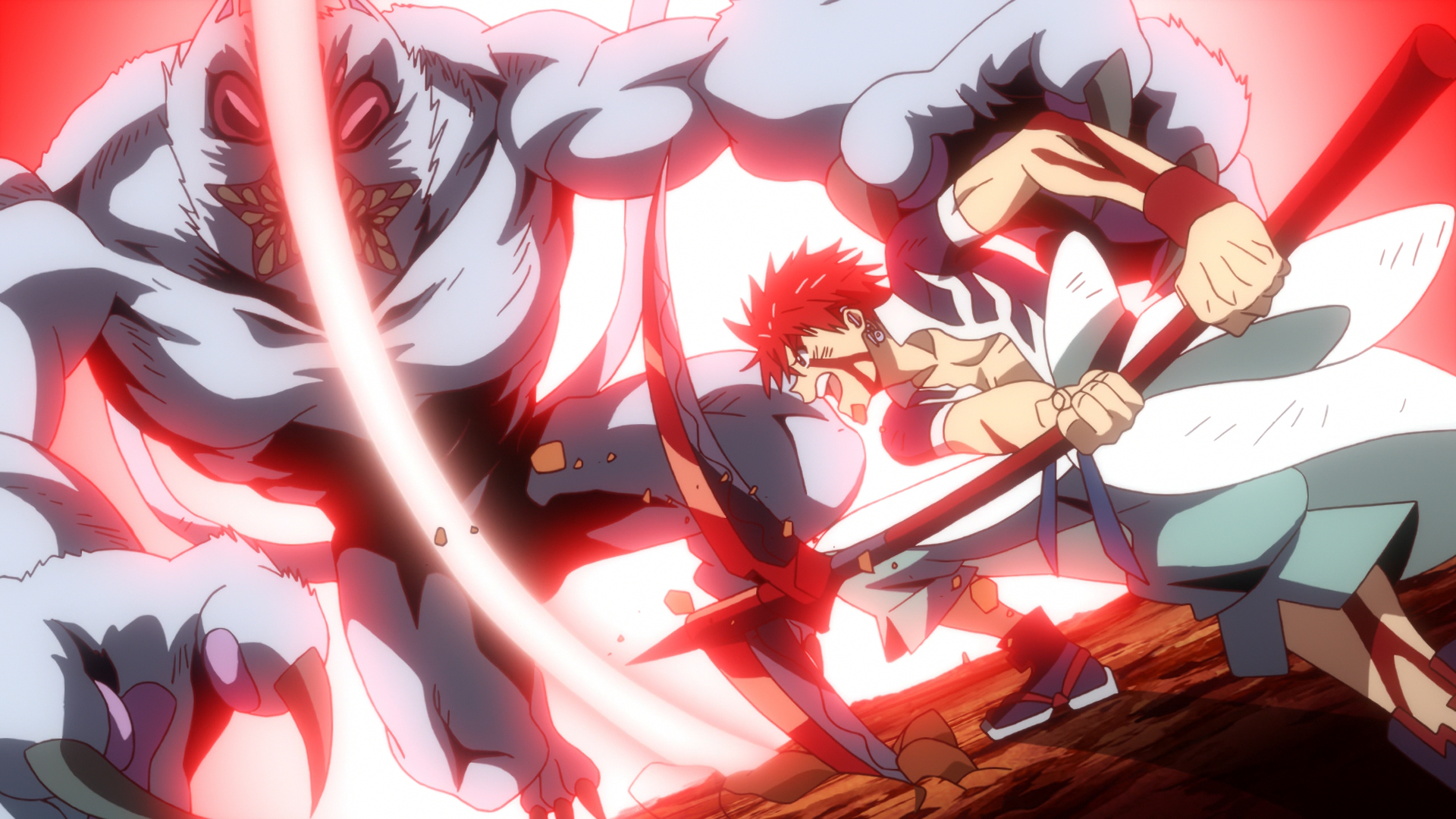
All that said, this isn’t the worst thing airing this season, and honestly if you look past its low-budget visuals it’s enjoyable enough and is still okay. I see it resonating a bit more with younger viewers who might be new to anime, or anyone nostalgic for how shonen anime used to be before studios like Ufotable and Wit got their hands on it, but ultimately if you are interested in this series, you’re probably far better off just reading the manga, as I think you’ll appreciate what it’s trying to do a lot more than watching the show.

Something a bit more noteworthy is Tokyo 24th Ward, an interesting show that takes a little bit of a sci-fi angle on turning ordinary people into superheroes.
An anime original by CloverWorks, the series is set in the titular 24th Ward, a district of Tokyo centered on an island in Tokyo Bay, where a group of teenagers consisting of friends Shuta, Ran and Koki, Koki’s sister Asumi, and their childhood friend Mari, are involved in a horrific accident trying to rescue people from a fire at a local elementary school. As the building crumbles, Asumi is crushed and killed under debris trying to save Mari, while Ran could do nothing to save her. Now a year on and after reuniting at a memorial service, Shuta Ran and Koki start receiving mysterious phone calls from Asumi that, when answered, make each of them see visions of horrific life or death situations and are offered two choices on who to save (à la the trolley problem), while giving them seemingly superhuman powers to pull off what are essentially miracles. The three friends must now not only team up to defy these visions and save as many people as they can, but also solve the mystery these mysterious phone calls from their supposedly deceased friend.

I really like the idea behind this one, even if I’m not entirely convinced by its execution just yet. Its solid double-length opening episode really did it some favours as it did a great job of selling the characters and overall premise. The cast are a dumb but fun bunch who are all way out of their depth (which leads to some fun scenes), while the mystery set up by the phone calls is an interesting one. The dilemmas the cast are presented with are pretty tense, however the show does reveal some of its cards way too soon, as I can already think up some plausible reasons about what is going on. The way these dilemmas are orchestrated are also a bit too on the nose and aren’t particularly realistic, although there seems to be someone behind them, so they kind of fit at a stretch. There’s also an early structure appearing of one episode of setup, and another to tackle the dilemma, which kills the pacing when there’s not a lot going on with the setup.

Despite the faults, I think there’s enough here to keep me interested in seeing where this goes, even if it does seem a little predictable. If you want a sci-fi mystery that gives an interesting set of characters superpowers, I’d probably recommend you give this one a shot.

My final pick is the show that I’ve been enjoying the most this season, and that is My Dress-Up Darling.
Adapted from the manga by Shinichi Fukuda and animated by CloverWorks, the series focuses on Wakana Gojo, a first-year high school student who has always been seen as a bit abnormal due to his fascination with Hina dolls. Living with his grandfather, who is a Hina doll craftsman, he’s watched and picked up the same skills over the years and is seemingly en route to taking over the family business. As a result, he’s always been isolated by people his own age and has no real friends to speak of. However, that all changes when he gets involved in the antics of Marin Kitagawa, one of the most popular girls in his class, who, despite her stylish gyaru looks, is actually a complete nerd who likes to cosplay characters from anime and erotic visual novels. When Marin discovers Wakana using a sewing machine in school, she thinks it’s cool rather than creepy, and asks him to help her with the cosplay she is trying (and failing!) to make. Pleased to find someone who finally accepts him for who he is (and attracted by Marin’s good looks!) Wakana agrees to help her make costumes of all the various characters she adores.
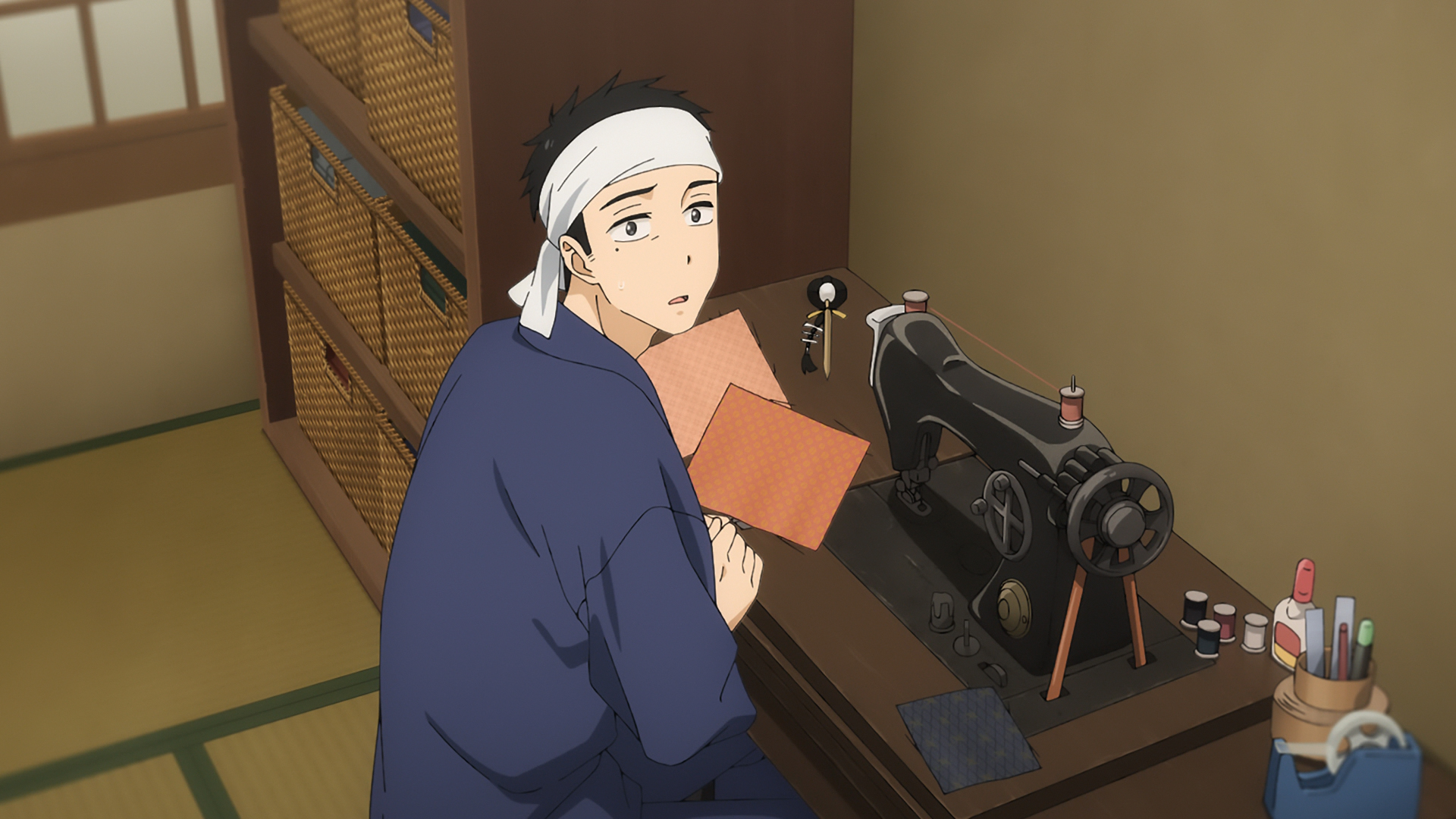
While some people may have criticised this series for its fanservice (including our own Ian Wolf with the manga), it’s actually not all that bad and is one of the most funny and easy to get into rom coms that I’ve seen in a while. I think that’s mostly because its characters work so well together as a duo, producing some great moments together despite their very different personalities.
Marin is great fun to watch and brings a lot of energy to the show as she just goes in with wild abandon and is not afraid or embarrassed to talk about and show what she loves. Wakana is the opposite of that, but he’s a cute and earnest young guy who is pretty relatable to anyone who has a niche hobby that they are embarrassed to tell others about.
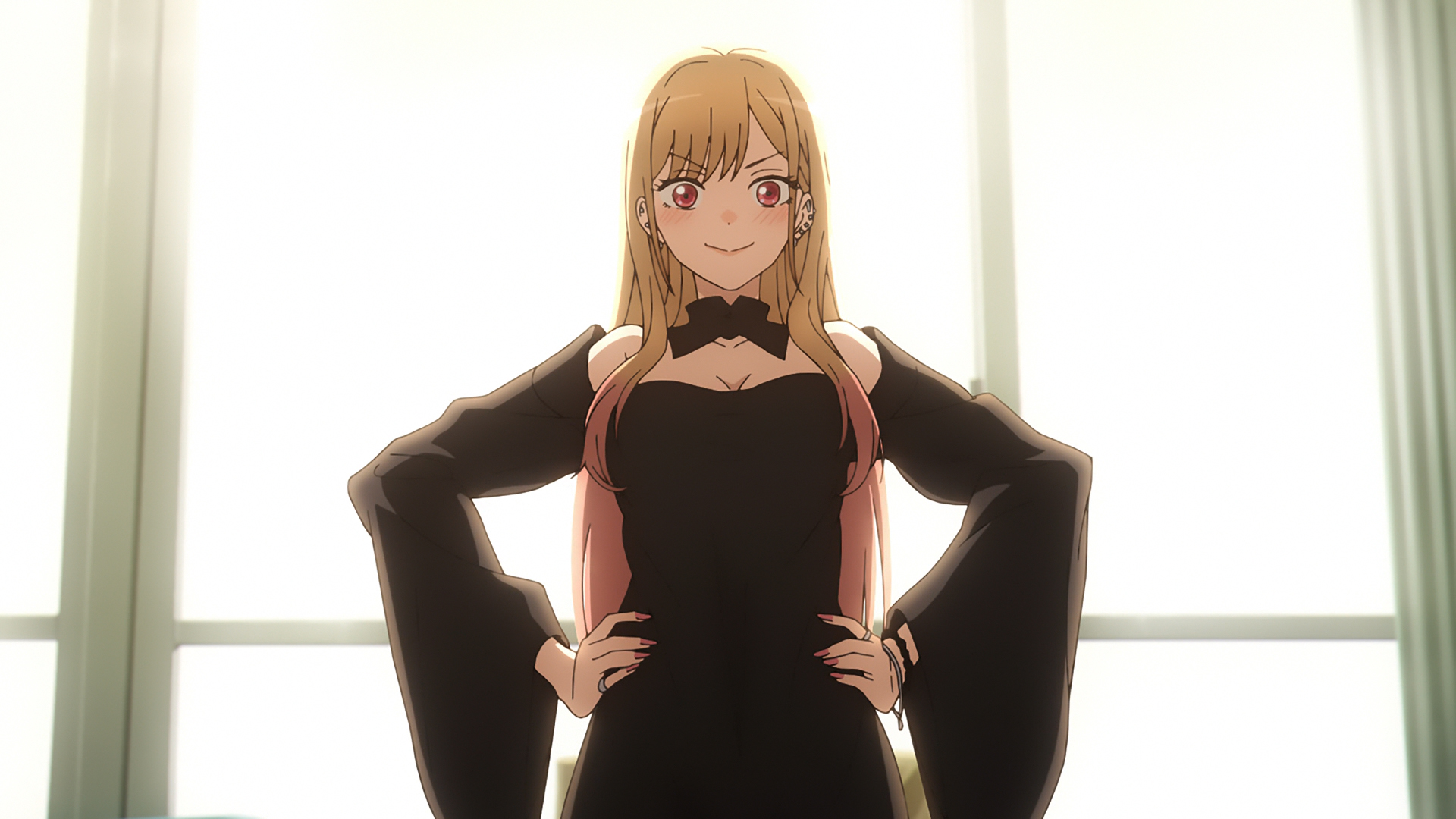
The show does have a strong message of being confident in loving what you do, and it definitely has a lot to say about not allowing people to tell you what you should like or not and that having a niche hobby is perfectly fine. So, while it does have this slightly pervy eye at times, it’s actually pretty heart-warming to see Wakana finally open up to someone. It has strong attention to detail for its subject matter too, and even though I haven’t cosplayed myself, I know from my friend’s experiences how hard the hobby can be sometimes, so it’s good to see it carry that feeling well. There’s also the promise of seeing real-life locations too – Ikebukuro features heavily in the opening, and you can see what is clearly the anime store Animate in there as well.
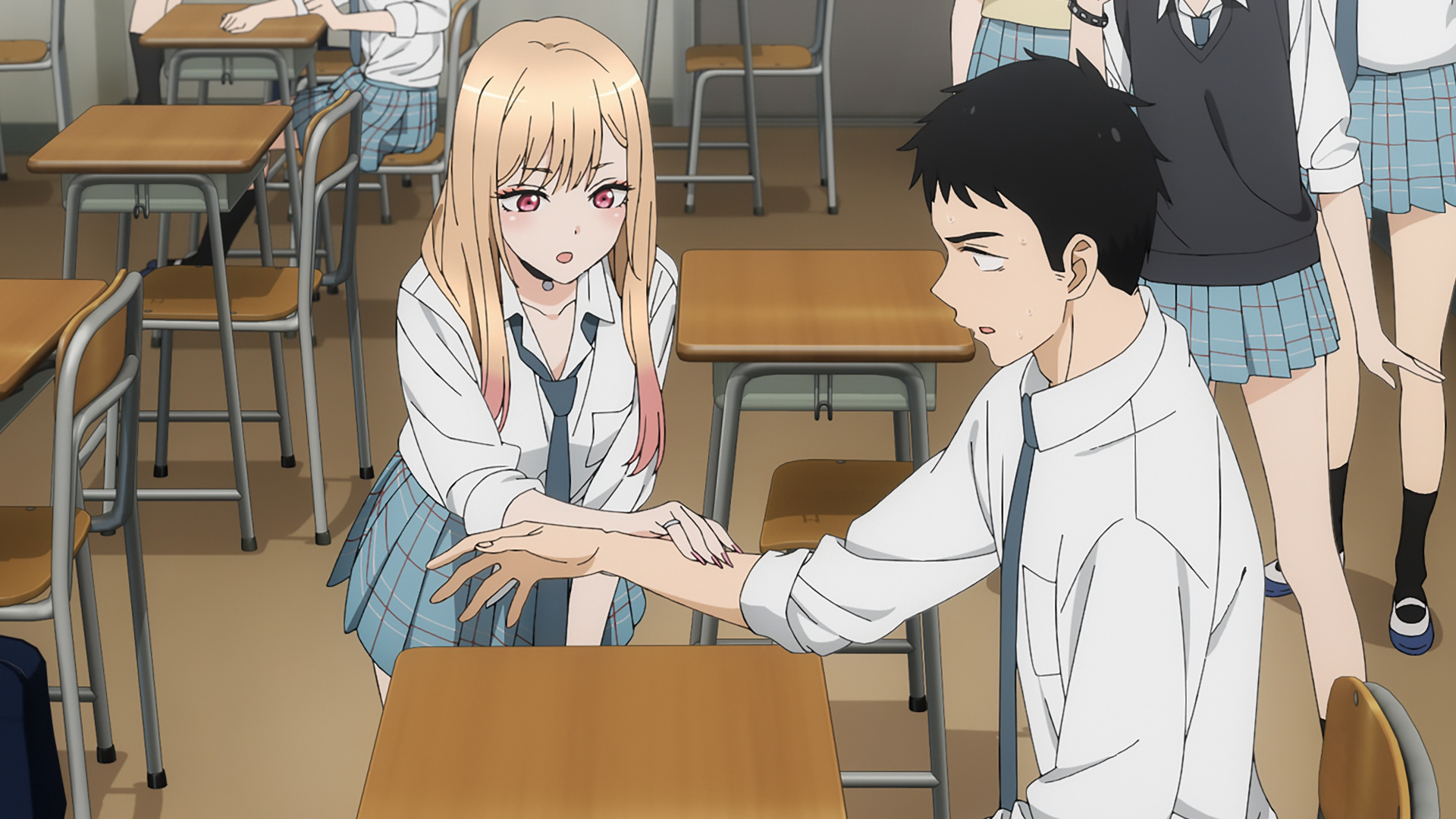
So far then, I can say I’m really enjoying this one. If you want an anime rom com that is funny, heart-warming, and knowledgeable about its subject matter then this is well worth checking out.
Orient is streaming exclusively on Crunchyroll, while My Dress-Up Darling and Tokyo 24th Ward are available on both Crunchyroll and Funimation.
Cold Cobra
I’ve found myself quite busy going into this Winter season, and with several series I watch continuing into it I don’t have as many or as varied thoughts as my fellow writers, but I do want to talk about the elephant, or indeed large naked man, in the room: Attack on Titan – The Final Season: Part 2.

Attack on Titan is something I’ve enjoyed watching from the start but never found time to read the original manga, so I’m looking forward to seeing how it ends (I’ve heard… mixed things…) After the first half of the season showed us the grander scope the series has now taken by having lead character Eren Yeager attack the country of Marley and steal new Titan powers to add to his collection before being saved by a full-on invasion from his allies from “Paradis” as his home island is apparently called. Just before the break he seemingly turned on everyone he previously cared about and is on board with a plan to euthanise his whole race to stop any more Titans from being created in the future, though his plan is soon interrupted by an invasion from Marley, pulling a reversal from the start of the series.
This is where this half of the season kicks off as Eren turns into his new and improved Titan form and begins to battle the Titans from Marley, including his old ally-turned-enemy Reiner. Meanwhile Eren’s old friends and allies are freed from their prison cell and begin umming and ahing about whether to actually go and help him any more since he’s dead-set on making sure none of them will ever have children again, but Armin, one of Eren’s closest friends, refuses to believe he is capable of doing that and thinks he MUST be playing along with the enemy plan until he can get a chance to turn the tables. No one is particularly convinced but they decide letting Marley wipe out their island isn’t exactly any better so rush to his aid. Only two episodes in and there has been plenty of action but then I suppose it’s to be expected given it’s the second half of the final part of the story. The series has already veered wildly from the original, very weird, set-up so I’m looking forward to seeing how it all ends, one way or another!
Attack on Titan: The Final Season is available on both Crunchyroll and Funimation.
HWR
So far this season has offered some decent anime titles, with several standing out to me including Police in a Pod, a story focused around two female police officers, Kawai and Fuji, and the everyday work they carry out protecting the public.
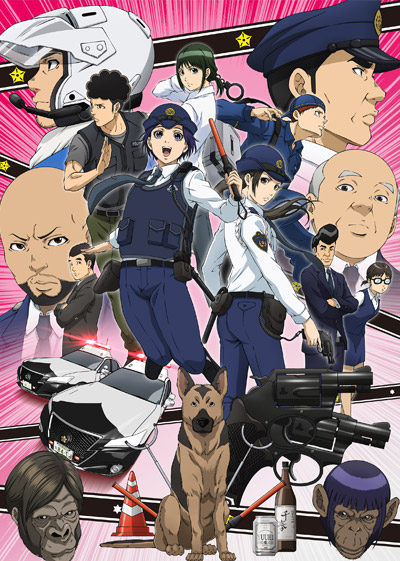
What makes the series a solid entry so far is its grounded nature and humour, with the two working appropriately even when dealing with more mature themes like teenage prostitution. I’m interested to see what storylines the series will explore over the next few weeks and also getting to know the supporting cast better.

Slow Loop fulfils the criteria for a fun and laidback fishing anime that I’ve missed since Diary of our Days at the Breakwater aired back in 2020. Hiyori makes for a likeable lead and her growing friendship with Koharu should make for an enjoyable watch this season.
Finally I’ll also give a nod to Miss KUROITSU from the Monster Development Department which looks like it could be fun but is still in the early stages of being enjoyable.
Police in a Pod and Slow Loop are available for streaming on Funimation and Miss KUROITSU from the Monster Development Department is available to stream on Crunchyroll.


